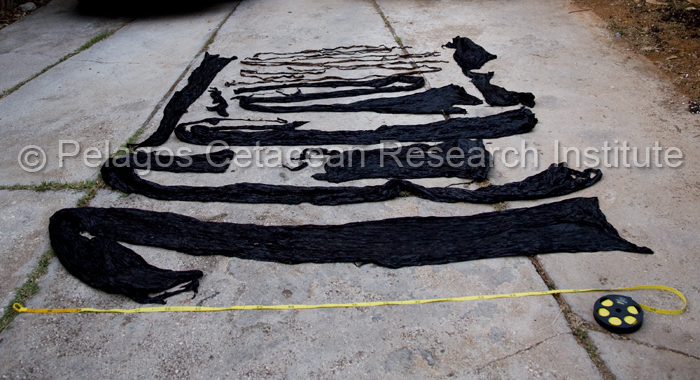
Photo credit: Pelagos Cetacean Research Institute / A. Frantzis
Here is another photo featuring plastic bags from a stomach, this time from the stomach of a Risso’s dolphin. Dr. Alexandros Frantzis, Scientific Director at the Pelagos Cetacean Research Institute in Greece sent me this photo and provided this explanation: “The photo shows the large quantity and size (the meter-tape used as scale is 2 meters [6.6 feet] long!) of plastic that was found in the stomach of a Risso’s dolphin. These plastic bags mistakenly ingested as squids provoked the death of the dolphin and are likely to originate from greenhouses (to cover them).”
Risso’s dolphins are pretty big animals averaging about 10 feet in length, but for one dolphin to be able to fit this much plastic into its stomach is shocking. I wrote back seeking clarification because I couldn’t believe it, I asked: “For the Risso’s dolphin, is that all you found in the stomach?! Just plastic bags?”
Dr. Frantzis replied: “There were some squid beaks as well in the stomach, but the dolphin was very emaciated and apparently could not feed properly for a long time, since the stomach was full of plastic bags. These animals have a horrible death accompanied by much suffering and pain.”
So this poor Risso’s dolphin was able to eat a few squid at some point, but there really wasn’t room for much else with all that plastic taking up important digestive space. I also asked Dr. Frantzis if using plastic on greenhouses was common in Greece because that’s not something I’ve seen in Los Angeles. He responded: “I have seen this practice several times, although I don’t live in the countryside and do not have proper knowledge. I am not sure if these were bags from green houses, but they seem so.”
His theory makes sense because if the plastic isn’t secured properly on a greenhouse roof, it’s definitely going to fly away and land in the Mediterranean Sea. And it’s tough to think of a good reason for needing a 6.6 foot long garbage bag. But here’s the real question: What is it about plastic that is confusing squid eaters?
As Dr. Frantzis explained in my post about the sperm whale with 100 plastic bags in its stomach, the whales and dolphins he’s finding with plastic in their stomachs are mainly or exclusively squid eaters. Underwater whales and dolphins don’t rely on their vision, instead they use echolocation to find and chase prey, but even this sophisticated sonar system isn’t always able to discern squid from plastic. Somehow large plastic bags underwater are confusing these deep divers. The similarities between large plastic bags and squid must be just enough to trick even experienced dolphins and whales with years of hunting under their belts. If only people didn’t let plastic fly into the ocean. If only plastic bags didn’t exist…
(Note: Thanks to Dr. Alexandros Frantzis and the Pelagos Cetacean Research Institute for sharing this photo and for all they do to help whales, dolphins and porpoises living in the Mediterranean Sea.)
Thanks for always alerting us to these troubling facts. Disturbing, but definitely need-to-know.